|
|
Post by Paste Pot Paul on Dec 15, 2015 14:51:20 GMT -5
10. Murray BallMurray Ball synthesized New Zealand's DNA and drip-fed it back to us from 1976-1994 in the newspaper strip Footrot Flats, the day to day life of Farmer Wal(lace) Footrot and his intrepid companion "dog". 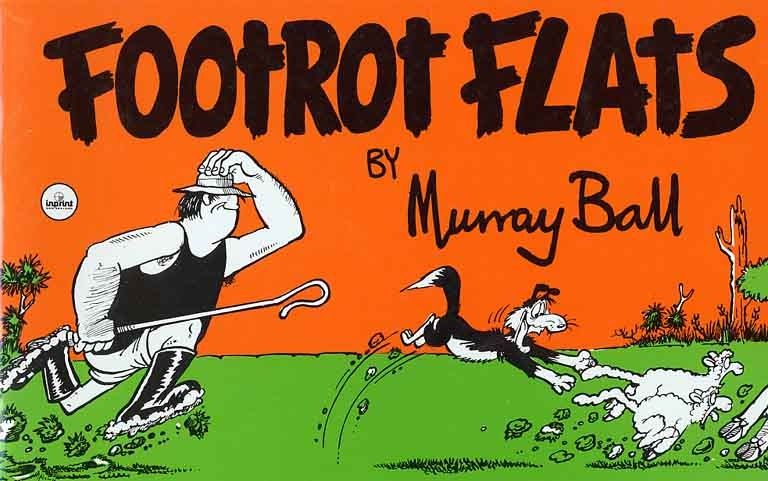 From Wikipedia From Wikipedia "The main character of the book, a Border Collie, thinks of himself as intelligent and tough, but is really quite soft and often cowardly. He has a real name, given to him by Aunt Dolly, but despises it and has never allowed anyone to reveal it, often going to great lengths to stop Aunt Dolly or anyone else from saying it. Aunt Dolly says it is a "such a refined, aristocratic name", which gives some clue as to why Dog despises it. Wal always calls him "Dog", gaining loyal devotion. The Dog is often put to use to guard things or get rid of rats or pigs, but Border Collies have an independent streak and the Dog's is a mile wide. However, also like others of his breed he is a competent sheepdog. He also has a couple of alter egos; "The Scarlet Manuka" who attempts to 'liberate' cricket balls from being hit by Wal and his team, "Mitey Iron Paw", and "the Grey Ghost of The Forest", that appear from time to time. The dog has also, at one point, claimed to have the following commendations: V.C. (Very Cute), D.S.O. (Doesn't Steal Offal), and B.A.R (What Sheep Do), along with the alias of '00Dog' (Licensed to be kind but fair) and acting as Wal's 'chaperone' in many cases in Wal's dates with "Cheeky" Hobson. The Dog thinks Cheeky is a cheap hussy and his chaperoning often leads to the date being a disaster for Wal." 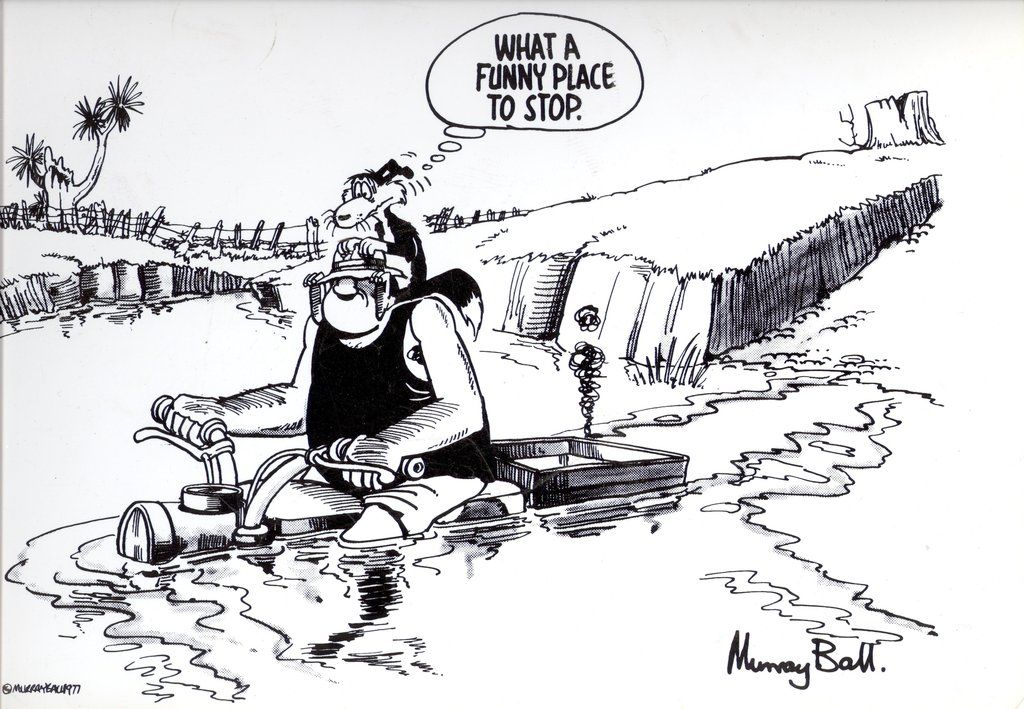 Its hard to tell how well the strip translates to other cultures, Australians would generally "get it", but I can see how most others would probably struggle. Its also extremely hard to put across just how much this captures the essence of being KIWI. 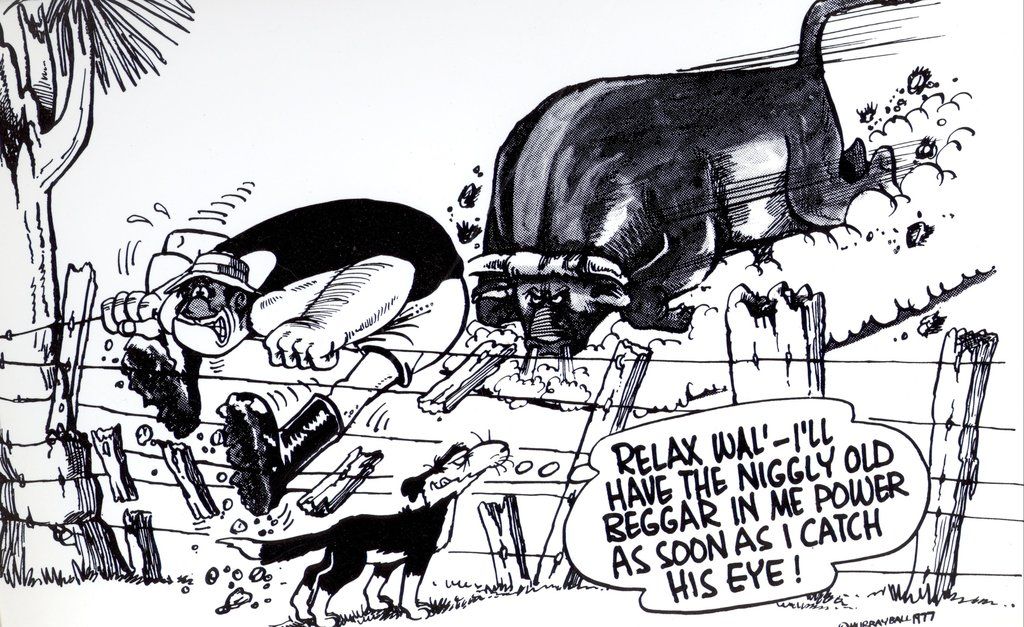 Even for those of us with limited contact with farming life, there is usually someone in the family who had hunting/fishing/sporting tales to rival Footrots. We had pets that behaved like the animals here and even saw our younger selves in the behaviour of "dog" as he encountered fierce pigs, errant corgis, lovesick romeos, hapless best mates, cheap hussys, and....Horse...the Terminator of the cat world, the ruler of Footrot territory and surrounding environs.  |
|
|
|
Post by hondobrode on Dec 15, 2015 15:13:44 GMT -5
#10. George Perez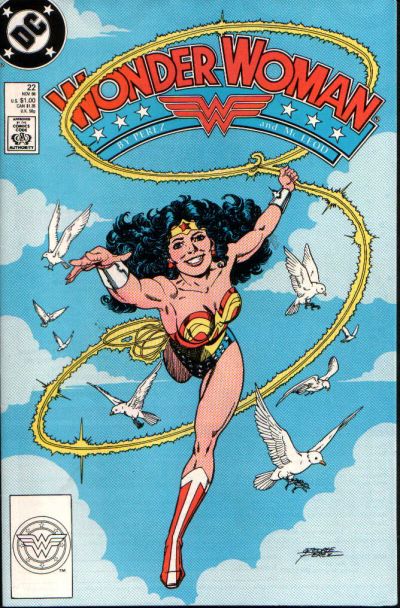 In addition to being a favorite artist of mine, Perez has the unique honor of being (so far as I know) the only comic book creator to ever single-handedly define a core American superhero. Superman, Batman, Spider-Man, Captain America and the like were all the products of creative teams, and even their most iconic iterations were the results of more than one contributor*, but Perez spent half a decade making one of the most iconic heroes in American Mythology entirely his own. Instead of depicting WW as just the girl of the group, or relying on easy tropes like being a strong but simplistic feminist, a femme fatale, or an aggressive and tough Amazon warrior, he gave Diana a rich and endearing complexity that truly stuck, and he reinforced it through both his writing and his artwork. The image above conveys it perfectly: though she is both strong and attractive, neither are emphasized -- instead what comes across is her idealism, naivete, courage, and joy. She is infinitely complex and real, never reducible to a stereotype, and Perez's writing and art worked together to give us this amazing spirit and personality. I'm not convinced anyone ever captured the character better, before or after. This is the definitive Wonder Woman, and Perez did it all on his own. * Yes, you could argue Frank Miller did this with Batman too, but he did it for all of four issues, not a full run, and I would argue his interpretation was heavily influenced by the work of creative teams that came before him. I loved his post-Byrne reboot Superman, and later his creator-owned Crimson Plague, as well. |
|
|
|
Post by hondobrode on Dec 15, 2015 15:15:29 GMT -5
#10 V.T. Hamlin I’m of a generation that grew up when comic books were at best mocked and at worst vilified for their effects on young people. If they were tolerated at all, it was as a diversion for little kids. You certainly weren’t going to read them beyond the age of 9 or 10. If you did, parents might punish you and peers would laugh at you. More on that some other time. I mention this because the same opprobrium did not apply to the Sunday funnies for whatever reasons. A kid like me could lie on the floor with the funnies spread out in all their four-color, broadsheeted splendor and luxuriate in them like a pig in poop. When I look back on the time I spent immersed in the fun and the suspense, the adventure and the silliness, and the many plots and sub-plots in those seemingly endless pages, I might as well have been reading a Dickens novel.  Today’s choice is another one drawn from that well of happy memory, V.T. Hamlin’s “Alley Oop,” a strip that began in the Stone Age and the rivalry between the kingdoms of Moo and Lem (as in Mu and Lemuria), and eventually made its way through many corridors of history, from Imperial Rome and Sherwood Forest to Ancient Egypt and the 20th century. It combined time travel, dinosaurs, romance, satire, and adventure centered around a kind of Paleolithic Everyman who rolled with the flow and used his brawn, his courage and his wits to survive culture shock like you wouldn’t believe. Like so many of the other comic strips I loved, the language in “Alley” was as charming as the art. Many of the names were elaborate puns: Alley’s name was a play on the French expression, “Allez, hop!” His curvaceous girlfriend, Oola certainly owed the origins of her monicker to the sexy French phrase, “Ooh, la la!” The scientist whose time machine brought Alley to 1939 was Professor Elbert Wonmug. As a kid, I just thought it was funny, but when I got older, I realized it was a play on ein stein, or “one mug.” His assistant (and eventual villain of the strip), Dr. G. Oscar Boom (G.O. Boom), was the lucky man whom Wonmug sent back to the age of dinosaurs to retrieve a specimen or two. Instead, Oscar comes back with Oop. When Wonmug says, “That’s impossible. There were no cave men in the time of the dinosaurs.”  Oscar ‘s reply is succinct, but stirring, and may even serve as a slogan for all comics: “Behold the impossible.” And with that, Oop’s many exploits as a stranger in strange lands begin. Hamlin’s art is delightful. His dinosaurs and prehistoric mammals are exquisite, his versions of the many exotic settings for Oop’s unique. His love for history, geology and paleontology are evident. His art is dynamic and detailed, notable for its meticulous cross-hatching, but fun, too, as if Harold Foster and Larry Gonick had a baby. His Stone Age folks are cartoony, with their Popeye-like forearms and calves – Oola being a notable exception! -- but their contemporary dialogue and sensibilities and expressive faces make them just like you and me. His layouts remind you of Eisner's work on The Spirit,  even the lettering contributes to the narrative, here as Oop disappears into time:  Just a beautiful, clever, fun strip. Its like will never be seen again in newspapers, that's for sure. I envy anyone plunging into them for the first time.   Hamlin came SO close to making my list. |
|
|
|
Post by hondobrode on Dec 15, 2015 15:43:31 GMT -5
#10 is the brilliant Bill Watterson and his delightful Calvin & Hobbes. His delightful strip of 6 year old Calvin and stuffed tiger Hobbes stylistically blends bits of Peanuts, Pogo, and Krazy Kat. The strip feels right like a child's mind would probably feel.  |
|
|
|
Post by foxley on Dec 15, 2015 15:57:41 GMT -5
Grell just missed my list. He was #13, principally for his work on Green Arrow: The Longbow Hunters. Good to see him getting some love. He'll be getting some more.  |
|
|
|
Post by Deleted on Dec 15, 2015 16:13:20 GMT -5
#10. George Perez In addition to being a favorite artist of mine, Perez has the unique honor of being (so far as I know) the only comic book creator to ever single-handedly define a core American superhero. Superman, Batman, Spider-Man, Captain America and the like were all the products of creative teams, and even their most iconic iterations were the results of more than one contributor*, but Perez spent half a decade making one of the most iconic heroes in American Mythology entirely his own. Instead of depicting WW as just the girl of the group, or relying on easy tropes like being a strong but simplistic feminist, a femme fatale, or an aggressive and tough Amazon warrior, he gave Diana a rich and endearing complexity that truly stuck, and he reinforced it through both his writing and his artwork. The image above conveys it perfectly: though she is both strong and attractive, neither are emphasized -- instead what comes across is her idealism, naivete, courage, and joy. She is infinitely complex and real, never reducible to a stereotype, and Perez's writing and art worked together to give us this amazing spirit and personality. I'm not convinced anyone ever captured the character better, before or after. This is the definitive Wonder Woman, and Perez did it all on his own. * Yes, you could argue Frank Miller did this with Batman too, but he did it for all of four issues, not a full run, and I would argue his interpretation was heavily influenced by the work of creative teams that came before him. Just to give credit where credit is due though-I remember reading in the fan press of the time that Greg Potter who is listed as co-plotter and scripter of the first few issues of the run, supposedly did a lot of the heavy lifting for the reboot (in close communication with Karen Berger who was the series editor), outlining and defining how Amazonian society would work, doing character outlines for the gods and the Amazonian cast, outlining the direction etc. and essentially pitching the idea for the rebooted Wonder Woman and Perez was brought on as a co-conspirator to give some name recognition to the project and they meshed well and Perez contributed a lot, Potter didn't hold up to the rigors of a monthly deadline, and bowed out a few issues in, but a lot of the tone, direction and foundation for this iteration is his work, not Perez's alone even though Perez is the one that executed the vision throughout the run. So it is not quite Perez single-handedly defining an American icon, he built on the work of someone else involved on the project and took it beyond that person's initial contribution, but it wasn't all Perez. -M |
|
|
|
Post by Prince Hal on Dec 15, 2015 16:20:20 GMT -5
#10 is the brilliant Bill Watterson and his delightful Calvin & Hobbes. His delightful strip of 6 year old Calvin and stuffed tiger Hobbes stylistically blends bits of Peanuts, Pogo, and Krazy Kat. The strip feels right like a child's mind would probably feel. 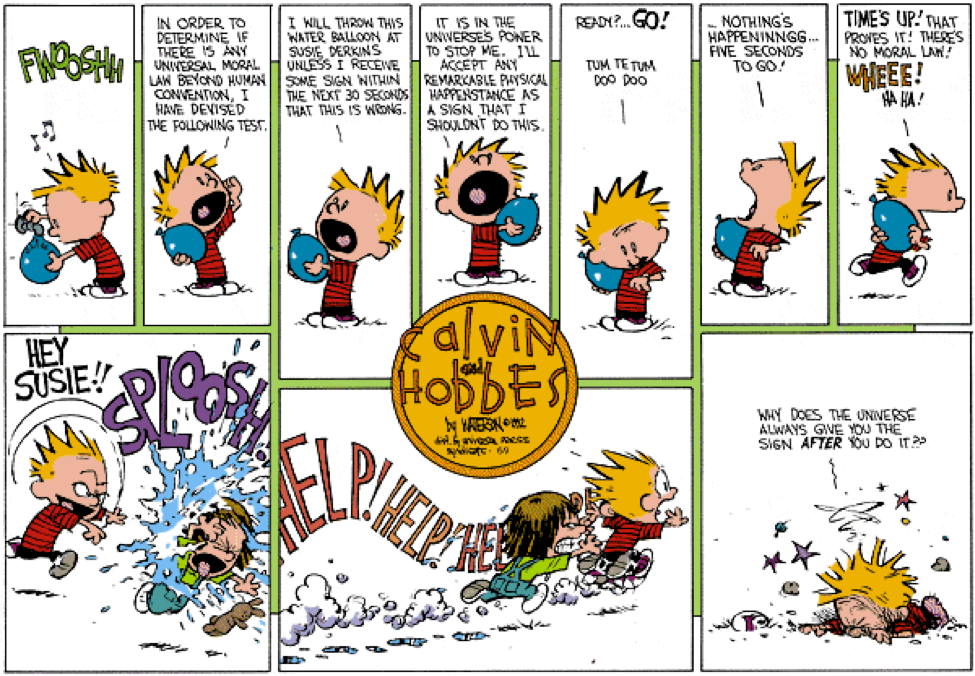  I can guarantee you'll see more on this work of genius as the days go by... How can there be a list like this without the little guy and his tiger? |
|
|
|
Post by MDG on Dec 15, 2015 16:33:15 GMT -5
#10 is the brilliant Bill Watterson and his delightful Calvin & Hobbes. His delightful strip of 6 year old Calvin and stuffed tiger Hobbes stylistically blends bits of Peanuts, Pogo, and Krazy Kat. The strip feels right like a child's mind would probably feel. This is why I stayed away from strips--they'd quickly take over the whole list. Not many people could outrank just the four mentioned here when they were at their peak (not to mention Herriman, McManus, Raymond--Rip Kirby, not Flash, Roy Crane, Al Capp, Caniff.... and that's from reading maybe 2% of what they produced.) |
|
Crimebuster
CCF Podcast Guru
Making comics!
Posts: 3,958  Member is Online
Member is Online
|
Post by Crimebuster on Dec 15, 2015 17:14:08 GMT -5
Grell just missed my list. He was #13, principally for his work on Green Arrow: The Longbow Hunters. Good to see him getting some love. He'll be getting some more.   |
|
|
|
Post by thwhtguardian on Dec 15, 2015 17:24:42 GMT -5
#10 is the brilliant Bill Watterson and his delightful Calvin & Hobbes. His delightful strip of 6 year old Calvin and stuffed tiger Hobbes stylistically blends bits of Peanuts, Pogo, and Krazy Kat. The strip feels right like a child's mind would probably feel.   Waterson just missed my list, I love his work; it's just so poignant and imaginative. |
|
|
|
Post by thwhtguardian on Dec 15, 2015 17:49:28 GMT -5
On the Third Day of Classic Comics Christmas I give unto thee... Osamu Tezuka Known mostly for his excellent work on Astro Boy Tezuka was even better in Phoenix and Buddha which tackled much more mature themes. 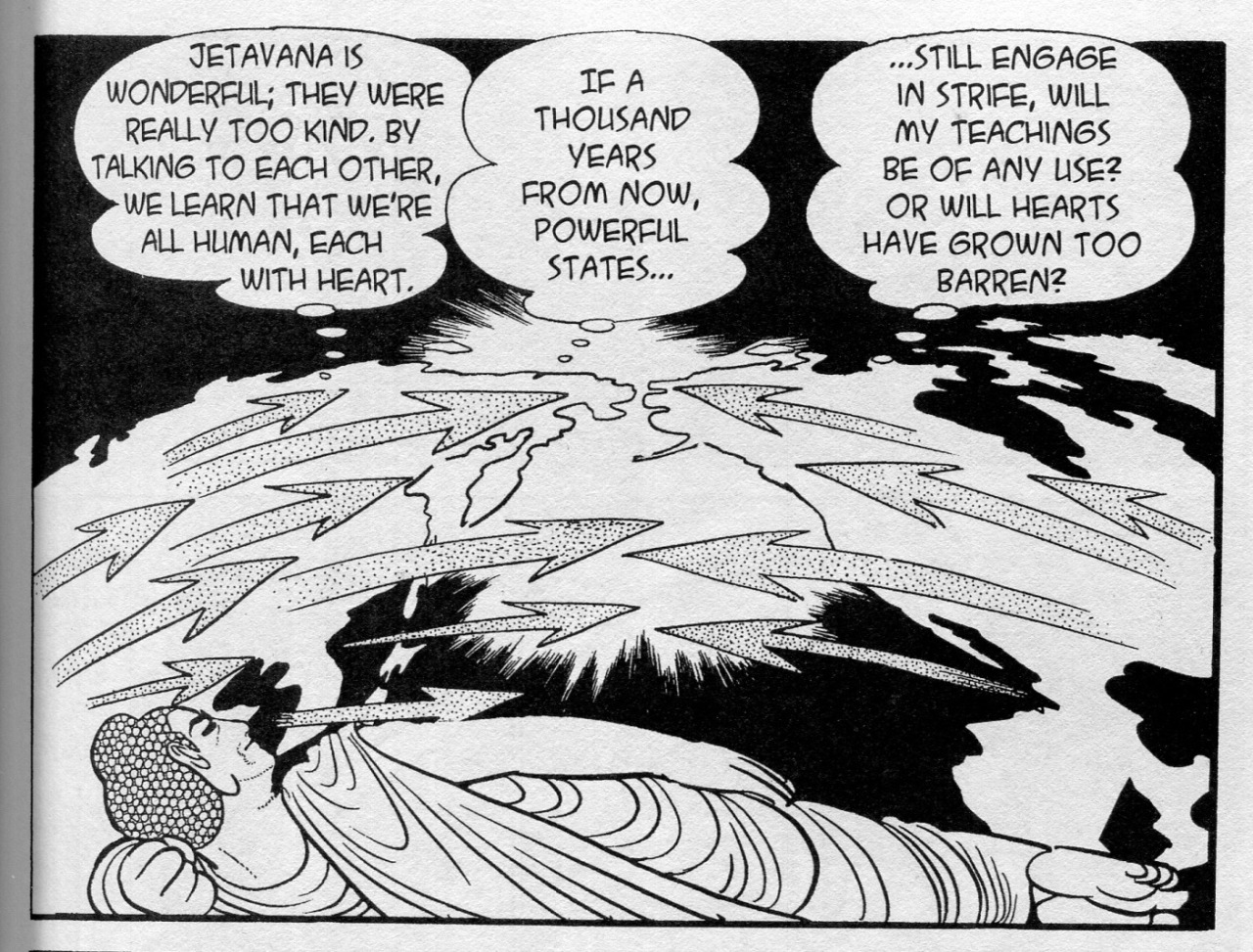 Despite that however he maintained a clear and deceptively simple art style. At first glance his art comes off as almost childlike in its simplicity but when viewed closely the inner complexities are clear; although basic they are perfectly balanced which creates a very classical feel to his work which really keeps your eyes glued to the art almost to the exclusion to the text which is an awesome feat. In addition to that he has a really cinematic style when it comes to the way he portrays action: |
|
shaxper
CCF Site Custodian
Posts: 22,862
|
Post by shaxper on Dec 15, 2015 18:13:48 GMT -5
#10. George Perez In addition to being a favorite artist of mine, Perez has the unique honor of being (so far as I know) the only comic book creator to ever single-handedly define a core American superhero. Superman, Batman, Spider-Man, Captain America and the like were all the products of creative teams, and even their most iconic iterations were the results of more than one contributor*, but Perez spent half a decade making one of the most iconic heroes in American Mythology entirely his own. Instead of depicting WW as just the girl of the group, or relying on easy tropes like being a strong but simplistic feminist, a femme fatale, or an aggressive and tough Amazon warrior, he gave Diana a rich and endearing complexity that truly stuck, and he reinforced it through both his writing and his artwork. The image above conveys it perfectly: though she is both strong and attractive, neither are emphasized -- instead what comes across is her idealism, naivete, courage, and joy. She is infinitely complex and real, never reducible to a stereotype, and Perez's writing and art worked together to give us this amazing spirit and personality. I'm not convinced anyone ever captured the character better, before or after. This is the definitive Wonder Woman, and Perez did it all on his own. * Yes, you could argue Frank Miller did this with Batman too, but he did it for all of four issues, not a full run, and I would argue his interpretation was heavily influenced by the work of creative teams that came before him. Just to give credit where credit is due though-I remember reading in the fan press of the time that Greg Potter who is listed as co-plotter and scripter of the first few issues of the run, supposedly did a lot of the heavy lifting for the reboot (in close communication with Karen Berger who was the series editor), outlining and defining how Amazonian society would work, doing character outlines for the gods and the Amazonian cast, outlining the direction etc. and essentially pitching the idea for the rebooted Wonder Woman and Perez was brought on as a co-conspirator to give some name recognition to the project and they meshed well and Perez contributed a lot, Potter didn't hold up to the rigors of a monthly deadline, and bowed out a few issues in, but a lot of the tone, direction and foundation for this iteration is his work, not Perez's alone even though Perez is the one that executed the vision throughout the run. So it is not quite Perez single-handedly defining an American icon, he built on the work of someone else involved on the project and took it beyond that person's initial contribution, but it wasn't all Perez. -M Potter lasted all of two issues, but looking closer now, Perez got a lot of assists from Len Wein, who did the scripting on those early issues after Potter left. So yes, it looks like I'll have to temper my enthusiasm a few degrees. But only a few. |
|
|
|
Post by Deleted on Dec 15, 2015 19:40:38 GMT -5
Just to give credit where credit is due though-I remember reading in the fan press of the time that Greg Potter who is listed as co-plotter and scripter of the first few issues of the run, supposedly did a lot of the heavy lifting for the reboot (in close communication with Karen Berger who was the series editor), outlining and defining how Amazonian society would work, doing character outlines for the gods and the Amazonian cast, outlining the direction etc. and essentially pitching the idea for the rebooted Wonder Woman and Perez was brought on as a co-conspirator to give some name recognition to the project and they meshed well and Perez contributed a lot, Potter didn't hold up to the rigors of a monthly deadline, and bowed out a few issues in, but a lot of the tone, direction and foundation for this iteration is his work, not Perez's alone even though Perez is the one that executed the vision throughout the run. So it is not quite Perez single-handedly defining an American icon, he built on the work of someone else involved on the project and took it beyond that person's initial contribution, but it wasn't all Perez. -M Potter lasted all of two issues, but looking closer now, Perez got a lot of assists from Len Wein, who did the scripting on those early issues after Potter left. So yes, it looks like I'll have to temper my enthusiasm a few degrees. But only a few. I don't know, I think Perez's Wonder Woman would have been vastly different if he weren't handed Potter's version of the Amazons and Paradise Island as a starting point, if for instance he had been given Azzarello's version of the Amazons instead, the end product would be vastly different than what it iwas even if Perez had been the one executing it. I think the foundation Potter provided in the establishing the core elements of the reboot is a lot more than a little help, certainly a lot more than the scripting Len Wein provided and at least equal to Wolfman's contribution to "Byrne's" reboot of Superman even if Potter didn't stay on the project as long. Most of his work was done before Perez came on board. Not that Perez's run was less than phenomenal, or that he didn't do the heavy lifting on the production of the run for most of it (he gave up the art and wrote part of it later in the run), but there were a lot of cooks in the kitchen so I don't think he single-handedly redefined Wonder Woman. -M |
|
|
|
Post by Action Ace on Dec 15, 2015 19:52:33 GMT -5
#10 is the brilliant Bill Watterson and his delightful Calvin & Hobbes. His delightful strip of 6 year old Calvin and stuffed tiger Hobbes stylistically blends bits of Peanuts, Pogo, and Krazy Kat. The strip feels right like a child's mind would probably feel. This is why I stayed away from strips--they'd quickly take over the whole list. Not many people could outrank just the four mentioned here when they were at their peak (not to mention Herriman, McManus, Raymond--Rip Kirby, not Flash, Roy Crane, Al Capp, Caniff.... and that's from reading maybe 2% of what they produced.) I just let the chips fall where they may. And the strips took over my list.  |
|
|
|
Post by hondobrode on Dec 15, 2015 19:58:24 GMT -5
On the Third Day of Classic Comics Christmas I give unto thee... Osamu Tezuka Known mostly for his excellent work on Astro Boy Tezuka was even better in Phoenix and Buddha which tackled much more mature themes.  Despite that however he maintained a clear and deceptively simple art style. At first glance his art comes off as almost childlike in its simplicity but when viewed closely the inner complexities are clear; although basic they are perfectly balanced which creates a very classical feel to his work which really keeps your eyes glued to the art almost to the exclusion to the text which is an awesome feat. In addition to that he has a really cinematic style when it comes to the way he portrays action: THIS is who just missed my list as well. Literally, he was the next one down. I've been exposed to it but have never read more than a few pages, but I love what I see. |
|





























